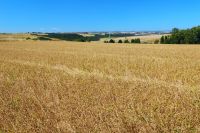Persistent La Niña Is Back Again

La Niña is back less than three months after the end of its last appearance, a particularly strong event that contributed to driving up global food prices.
The new La Niña will continue the largely dry conditions in important agricultural regions in Brazil and Argentina as well as the southern United States and hurt yields of soy and wheat, experts say.
'Multi-year La Niñas are not uncommon,' said Jeff Masters, co-founder and director of meteorology for Weather Underground, the web’s first commercial weather service.
'The last was between 1998 to 2001 with a few months of neutral conditions like this year,' Masters told Tierramérica.
La Niña and El Niño are, respectively, the cold and warm phases of the famous El Niño-Southern Oscillation (ENSO), a cyclical climate phenomenon that affects weather patterns around the world.
ENSO is part of the system that regulates heat in the eastern tropical Pacific Ocean and is driven by changes in surface ocean temperature and air pressure.
'ENSO is undoubtedly being affected by climate change,' said Masters.
Emissions from burning fossil fuels act like an extra blanket in the atmosphere trapping additional heat from the sun. A warmer planet has more energy to power stronger storms, hotter heat waves, more intense droughts, and heavier flooding rains, he said. However, we are just beginning to understand how ENSO might change in the future with climate change, Masters stressed.
The previous La Niña started in June 2010 and brought heavy rains to Australia, ending its ten-year drought but also flooding more than 850,000 square kilometres, an area equivalent in size to France and Germany combined.
It also brought record flooding to northern South America, including Colombia and northern Brazil. At the same time, central and southern Brazil, Argentina and the southern portion of the continent experienced drought conditions.
'Projections indicate this La Niña will be weaker,' said Masters.
However, the impacts will be amplified by the fact that many regions have not recovered from last year's La Niña.
Central America, Venezuela, Colombia and other regions that experienced record flooding last December and January can expect more torrential rains in the coming months based on the seasonal forecast, he said.
As a result of climate change, the Earth's atmosphere is on average 0.8 degrees warmer, and that allows it to hold four percent more water vapor, Kevin Trenberth, a senior climate scientist with the National Center for Atmospheric Research (NCAR) in the central U.S. state of Colorado, told Tierramérica.
'The extra moisture goes with the sea temps and has impacts on everything. Where it is warm in La Nina, there is more risk of flooding,' Trenberth said in an email interview.
How climate change will affect the complex three- to seven-year ENSO cycle is currently beyond the capabilities of computer climate models, he said.
While flooding and droughts have become measurably worse, there is no clear evidence that climate change has affected the ENSO cycle itself, Trenberth told Tierramérica previously.
The current La Niña is expected to peak in January and end in the spring, said Masters. That will bring dry conditions to Texas and other parts of the southern U.S. already suffering from extreme drought.
'Droughts tend to generate high pressure systems that act as positive feedback reinforcing the conditions that produce drought,' he said.
Less than 130 millimeters of rain has fallen in Texas this year, breaking all records and resulting in five billion dollars in crop and livestock losses. Agriculture in the region is facing a long difficult road that will require several seasons of heavy rain to recover from, he said.
Agriculture experts at the U.S. Department of Agriculture say there is 'high potential for winter wheat failure' and 'potential failure of summer crops' in 2012 throughout the U.S. southern plains region if La Niña continues.
According to Oil World, an agriculture forecasting service in Hamburg, Germany, soy and other crops are threatened by expected drier conditions in much of Argentina and southern and central Brazil.
'Central Brazil has experienced unusually dry conditions since mid-April,' Oil World wrote in a report released on Sep. 30.
Parts of Argentina received much less than half their normal rainfall. Without good rains in October and November, yields will plummet, it predicted.
World food prices remain 26 per cent higher than a year ago, according to the Food and Agriculture Organisation (FAO) Food Price Index published last month.
Cereal stocks remain low but the forecast yields are expected to be three per cent higher than last year. However, this forecast was made in June, before the current La Niña took hold.
* The author is an IPS correspondent. This story was originally published by Latin American newspapers that are part of the Tierramérica network. Tierramérica is a specialised news service produced by IPS with the backing of the United Nations Development Programme, United Nations Environment Programme and the World Bank.
© Inter Press Service (2011) — All Rights ReservedOriginal source: Inter Press Service
Where next?
Browse related news topics:
Read the latest news stories:
- Mayan Farmers Improve Their Livelihoods and Polyculture of Milpa in Mexico Monday, November 25, 2024
- Free Cesarean Sections in Nigeria: Can This Policy Truly Deliver? Monday, November 25, 2024
- UNiTE: Violence Against WomenA Plight That Spares No Country Across All Continents Monday, November 25, 2024
- 60 Percent of Femicides Are at the Hands of a Partner or Family Monday, November 25, 2024
- Sudan Ravaged By Disease, Famine, and War Monday, November 25, 2024
- Ensuring Violence-Free Homes for Sri Lankan Women Monday, November 25, 2024
- Its About our Entire Planet: The Pandemic of Violence Against Women Monday, November 25, 2024
- Youth take over at UN Alliance of Civilizations Monday, November 25, 2024
- Lebanon: UNIFIL concerned by attacks on Lebanese Armed Forces Monday, November 25, 2024
- ‘No excuse’: A global call to end violence against women Monday, November 25, 2024